If you were born anytime after the late 1960s, chances are, you, like me, grew up worshiping the Gods of Saturday Morning. You probably had a similar worship schedule to me. You would awaken far earlier than you would on a school day, you would not bathe, nor change out of your nightclothes from the night before. You would fill enormous bowls of easily-prepared cold breakfast cereal, you would race into whatever room the TV was in, and you would spend a good two to four hours laying or sitting prostrate, perhaps wigging from an unduly strong sugar rush, hungrily imbibing the offerings from whatever TV programmers felt you should be consuming. They probably didn’t know it at the time, but those TV programmers were shaping our pop consciousness.
But there were dangers and pitfalls. As we have likely learned as adults, we often had pretty crummy taste growing up, and revisiting some of these prized memories can result in embarrassment at the least, and utter horror at the most. Sure, some of these cartoons easily stand the test of time; “The Ren & Stimpy Show” is still pretty brilliant, I’m very fond of “Tiny Toon Adventures,” and, of course, anyone can get behind Warner Bros. animated shorts from the 1940s. However, if you grew up with them, I implore you not to go back and watch “The Transformers,” or “Inspector Gadget.”Why, why did we watch the 1980s version of “Alvin and the Chipmunks?” How did the bizarro sci-fi/dark ages mash up that is “He-Man and the Masters of the Universe” make any sense to us as children? And how can any generation answer for “Scooby Doo?”
Despite their weirdness, though, many of these shows are remembered with fondness and no small amount of nostalgia. I did watch all of the above mentioned shows on a regular basis, and did have a good time with them. I may be afraid to revisit them today, but still have nothing but affection for my Saturday Morning worship.
But the dark side of this fondness and nostalgia are the Horrors. The Dark Ones. The supporting characters that were so out-of-place, no obnoxious, so very grating and abrasive that, even as a child, you wondered why they were inserted into the show. The screeching, cutesy nightmares that were borne of bad ideas, and are now the fuel for rancor and nightmares. I, out of mere pique, and to have a little fun, have decided to compile a list of the ten most annoying animated characters from years past.
(First, a ground rule: The character cannot have been intentionally annoying. A lot of my friends like to cite the squealing, cooing, animal-torturing Elmyra from “Tiny Toon Adventures” as a really obnoxious character. Well, indeed she was annoying, but she was engineered to be that way; she served as a villain on the show, and, in that capacity, was a flying success (and even kind of brilliant, in a way). Others might site the protractedly weird characters from some of The Cartoon Network’s Adult Swim lineup. Again, they are designed to be kind of off-putting. No, these characters must stand out in stark contrast to their surroundings. They must have been clearly created to entertain, only to achieve the opposite effect. They must induce in the viewer, a terrifying need to smack them in the face and light them on fire).
10) Needle from “Conan the Adventurer” (1992-1993)
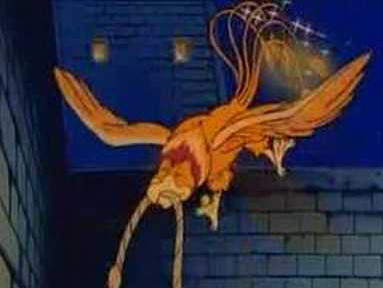
“Conan the Adventurer” (not to be confused with the 1997 live-action series of the same name) was a pretty flimsy show that was, like many of its peers of the 1980s and 1990s, merely trying to bank on an established property, this case the 1982 Arnold Schwarzenegger film. Its premise was spare, but familiar: Conan, a muscled warrior of the Dark Ages, would wander the countryside battling despots, thieves and evil wizards. The show lasted 64 episodes (which is a lot for a single year’s run), and is largely dismissable and forgettable. I spawned its own spinoff called “Conan and the Young Warriors.”
But, we still have Needle. Let us not forget Needle. You see, our hero Conan had in his possession a magical shield with a phoenix crest. At a whim, the crest itself could spring bodily from the shield and fly about, aiding Conan. But, rather than be a poetic soul, or a thorny badass, Needle was a squeaking, parrot-like, anachronistic comic relief character, who would bitch and whine about his sidekick status in between begging for pomegranates. He referred to himself in the third person. Needle wasn’t quite as obnoxious as some of the other heavyweights on this list, but he did manage to rob an otherwise hardworking television series of any dignity it may have had.
9) Gurgi from “The Black Cauldron” (1985)
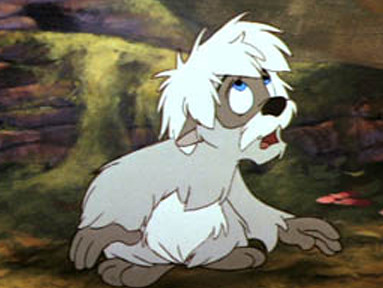
In the mid 1980s, the Disney feature animation studio was suffering both in quality and financially. In the notebooks of many an animation historian, the nadir could be represented by “The Black Cauldron,” a bare-faced imitation of “The Lord of the Rings” with a bad script and unmemorable characters. While the film looks fantastic, has a neat-looking villain, and is even possessed of some truly scary skeleton monsters, the film is kind of clunky, the story predictable, the boyish hero a kind of non-entity, and the conceit of a magical, fortune-telling pig a little hard even for little kids to buy.
But the film really begins to fall apart when our boyish hero, while out on a walk in the woods, meets the monster named Gurgi. Gurgi is a creature with the body of a monkey, the fact of a terrier, and the voice of Donald Duck’s less comprehensible brother. He longingly aches for food, and repeatedly calls apples “munchies and crunchies.” He lies, steals, and gives puppy dog eyes. He is the worst combination of conniving and adorable. The instant he appears, you hate him. Then you get the sinking sensation that he’s going to be with us the entire movie. Disney is known for its pusillanimous sidekicks, but Gurgi takes that cake.
If he were just an annoying sidekick, that would be bad enough, but he’s involved in a convoluted double bluff that earns him a spot on this list. During the film’s climax, the titular cauldron (which contains the soul of an evil sorcerer) can only be sealed if someone willingly sacrifices themselves. Gurgi, in a rare moment of introspection, begins to realize that no one likes him and throws himself into the pot. This is tragic, but it’s an ambivalent tragedy, as the audience clearly wanted him dead. But then the film, assuming we liked him, bothers to resurrect him. It’s one of the worst favors a bad film could have done.
8) Mindy from “Animaniacs” (1993-1998)
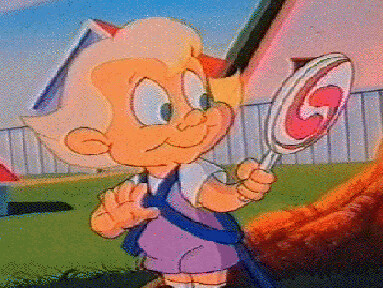
When you think about it, there’s nothing intellectual about “cute.” Cute is an emotional, gut reaction to stimulus. Studies have even proved that little of the brain is activated when presented with something that is merely adorable. And we all know what it’s like. Give me a good book, and I’ll devour it. But give me a basket of kittens, and I’ll put the book down to play with them.
But I object the sinister calculation of some filmmakers and TV designers when they deliberately try to make something that is adorable for its own sake. The most horrid offender of this phenomenon I can think of would be Mindy from “Animaniacs.”
Mindy is a one-joke character. She is a girl of about 4, who, when her parents are not looking, would blissfully flee her restraints, and go on merry adventures in the neighborhood. She only seems to dimly perceive the world about her, as she is often wandering into extremely dangerous scenarios, often at risk to her very life. The only thing protecting her from certain doom is the hard work and loyalty of her unappreciated pet dog Buttons, who is often trampled in her place. I’m tempted to make a martyrdom analogy. Buttons would then safely return Mindy to her cradle, only to be admonished for touching the baby. That poor dog.
Mindy is such a bland and blissful character that she is quickly nailed as a studio calculation. The insistent repetition of her cutesy catchphrases doesn’t help either. Mindy falls in the same camp as a lot of the Disney stable; they may have started as a real characters, but are now a bundle of orchestrated clichés and adorableness that appeal to your cute gland and give you cavities. As for me, I just want to slap the adorable off of that kid.
7) The Chipmunks from “Alvin & the Chipmunks” (1983-1991)

In the 1960s, Ross Bagdasarian thought to speed up the vocal tracks of his background singers, and bill their now-squeaky voices as the singing chipmunk act of a hard-working record producer. As a novelty record, I will proudly defend Alvin and the Chipmunks. “The Christmas Song” has become something of a standard, and even some of the recent Chipmunks albums have occasional merit (The Chippettes singing Missing Persons’ “Destination Unknown” is a bizarre pleasure).
But in the 1980s, when cartoons were all based on previous properties or toys, the Chipmunks were resurrected and mutated and made into bizarre horrors.
I have no problems with the squeaky voices, or even with their base character traits, necessarily (despite their blandness and broadness). I do, however, have a deep-seated objection to the very concept of flattening out the Chipmunks. The weird sitcom-like family dynamic, paired with the strange, mutated, 10-year-old-boys-with-big-round-peach-heads design they were given makes “Alvin & the Chipmunks” into a screechy, mental sunburn. If you can find footage of Alvin dressed as The Tooth Fairy somewhere on this great big Internet of ours, you’ll know what I’m talking about.
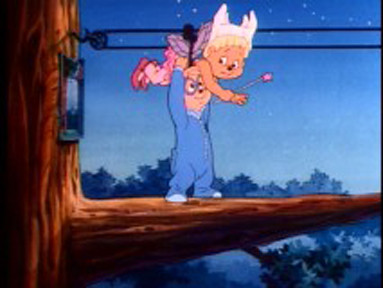
6) Slimer from “The Real Ghostbusters” and “Slimer” (1986-1991)

“Ghostbusters” (1986) is often considered one of the genre tentpoles of the 1980s, and today is still possessed of a wickedly creepy sense of humor rarely seen in modern films. I, like many my age, hold a strong affection for the film.
Oddly, though, the name “Ghostbusters” had already been claimed by an obscure 1975 sitcom (and, subsequently, Filmation’s 1986 cartoon), so when it came time to adapt the 1986 film for Saturday morning television, the title “The Real Ghostbusters” had to be used. They used stylized versions of the movie characters (careful not to make caricatures of the original actors), and even included a “sidekick” ghost that hung around with the titular ghost hunters. This was Slimer, a blurburing little glob of snot that smeared ooze over everything it touched, ate copious amounts of junk food, and didn’t really speak English. Slimer was supposed to serve as comic relief, but offered little more than squeaks and gluttony jokes.
The green ghost in the “Ghostbusters” movie, on which Slimer is based, wasn’t really properly named, as it was just a gluttonous spirit haunting an old New York hotel. The scenes with this ghost were so impressive, though, the nickname of “Slimer” was already floating around on the lips of the films’ fans. I posit this is not good enough reason to include a character in a TV adaptation. If you must adapt a show, please, cleave closely to the source material. Or diverge in interesting ways. Don’t give is this pabulum comedy relief duties.
5) Rhom from “Johnny Cypher in Dimension Zero” (1967)

Thanks to the hard work and steely resolve of stalwart animation historian Jerry Beck, I have been introduced to this obscure little oddity from the 1960s. “Johnny Cypher in Dimension Zero” was a sci-fi serial that played on TV in between longer programs, and featured some of the corniest dialogue and weakest characters in animation history. Johnny Cypher himself was a space-faring superhero who could transform into a miniature whirlwind, and bore his way through spaceships, deflect lasers, or perform whatever heroic tasks the situation called for. Johnny flew about space in his very own ship with his would-be girlfriend, and his squeaky alien sidekick Rhom.
Rhom. It’s hard to describe exactly what Rhom is. He’s an alien creature of some sort, with big, almond-shaped wasp eyes, and the physique of a human infant. It’s unclear if he was a character included to dispense space wisdom to Johnny, or if he was comic relief. Either way, listening to Rhom’s voice is a test of your mettle. Just looking at him gives one a strange queasy feeling. When you’re not wondering what the hell Rhom is, you’re gritting your teeth at his annoying, annoying “cuteness.”
4) Orbity from the revival of “The Jetsons” (1985, 1987)

Sitcoms (along with soap operas) are notorious for introducing new characters when ratings begin to slump after several successful years. Two words: Cousin Oliver. Or a better example: what was the name of The Fonz’s girlfriend?
In 1985, Hanna-Barbera decided to revive their popular 1962 series “The Jetsons” about a typical American family living in the future. They would fly about in jet cars, give orders to their robot maid, and push buttons to perform even the simplest of household tasks. The teenage daughter would gossip, the young boy would calmly do his homework, the wife would, well, also gossip, and the husband would go off to work every morning to be berated and belittled by his corporate masters. The dog could talk.
The revival was modestly successful, and ran for 41 episodes. In 1986, the show was taken out of production, only to make a last stumble onto the air in 1987. This time, though, the show’s producers decided to introduce a new pet into the Jetson household in the form or Orbity, a fuzzy little alien beast with big eyes, spring-loaded legs, antennae, and fur. Orbity would change colors like a mood ring, and squeal a lot. The household already had a cute talking pet, so it was unclear as to why Orbity was brought into the show. Maybe the producers felt they needed new blood to distinguish the revival from the original. Whatever the reason, we were inflicted with Orbity for far too many episodes, having to suffer through its every little quirk and superheroic deed. Orbity unduly changed the dimension of an already one-dimensional show.
3) Spritle Racer and Chim-Chim from “Speed Racer” (1967)
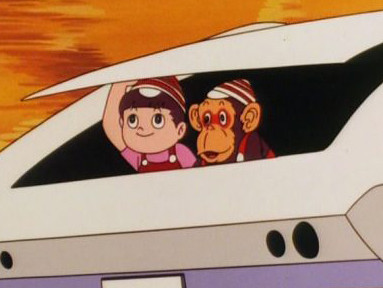
“Speed Racer” was the first television series to introduce the concept of Japanese animation to American audiences. It’s one of the most shoddy and simplest TV series ever conceived, but it was possessed of an enjoyable manic kookiness that has it surviving into the present as a cult hit. Indeed, in 2008, the series was adapted into a big-budget live-action film.
The premise was paper thin: Speed Racer is a race car driver who, with the help of his family, manage to win many car races. There are corporate wonks, cheaters, and wicked villains who would do Speed in, but Speed wins the race every time (and I guess he’d have to with a name like that). Speed would flirt with his would-be girlfriend Trixie, banter with Mom and Pops Racer, and scold the mischievous machinations of his little brother Spritle and Spritle’s pet chimpanzee Chim-Chim.
Is it possible to describe just how abrasive little Spritle really was? Or the sickening confusion one feels when watching Chim-Chim? Spritle was shrill, screamy, and shallow. Chim-Chim was jumpy and unpredictable. The pair was known for hiding in Speed Racer’s trunk during dangerous races, meaning they would also intentionally be putting their own lives in danger on a regular basis. To me, Spritle came across as slightly mentally retarded. His antics were queasy and horrifying. “Speed Racer” was silly enough without a “cute” little brother, so his presence was also extraneous.
Die, Chim-Chim, die.
2) The Great Gazoo from “The Flintstones” (1960-1966)
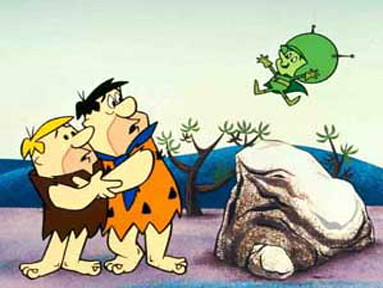
I have to admit, I am no fan of “The Flintstones.” The sloppy parody of “The Honeymooners” set during the Stone Age, complete with unlikable characters and a healthy dose of canned laughter, never appealed to me. I admire the show as a cultural turning point, and I appreciate how it pioneered animation to a broader more mainstream audience, but watching the show itself is a less than rewarding experience. The women are all status-obsessed, gossiping biddies, and the men are all dumb, squat, lazy oafs. I guess that’s fair, though, seeing as we are, technically, seeing a portrait of primitive man.
But then, sometime in the show’s final season, the producers came up with the stultifyingly absurd idea to write in a large-headed, floating green space alien with magical powers. The Great Gazoo is a banished alien who lands on Earth. The Great Gazoo is weird enough, but putting him in the Stone Age pushes on the membrane of surreality. He would smugly assert his superiority over the cavemen creeps he found himself amongst, and then vanish.
What? What the Hell? A green space alien, banished from his home, sent to Earth to mock cavemen, give them brontosaurus racing tips, and swan about, lording his superior powers over people who are barely smart enough to get about town? Even if your fevered mind can come up with some sort of mildly reasonable explanation for his presence on this show, one surely cannot get past his croony smugness.
1) Scrappy Doo from “Scooby Doo Where Are You!” (1968 ~ 1978)
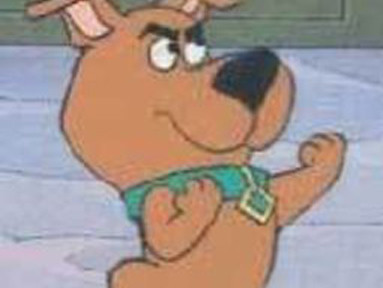
The heavy-hitter. The paramount. The pinnacle of all things horrifying and obnoxious in the world of cartoons. Scrappy Doo is the golden standard by which we compare all other annoying animated characters. Watching Scrappy Doo is akin to taking off your gas mask in a bunker full of tear gas. Why, oh why did Hanna-Barbera create such a grating personality?
The various “Scooby Doo” series, famously following a rogue cadre of teenagers who solves mysteries with their talking dog, were inexplicably popular in the 1960s and 1970s, and have become something of a cult classic, and a well-known staple of popular culture. However, back in 1970, when the show’s rating began to drop, and ABC threatened to cancel the show, Hanna-Barber did what most anyone would do, and introduced a new child character into the scene. This was Scooby Doo’s little bipedal cousin Scrappy Doo.
Scrappy not only walked upright, but seemed to speak better English than his uncle. He had an enormous dog head, but his body was small and spindly. He was a confrontational little bastard, who would charge into danger and offer to fistfight anyone or anything he encountered. And shivers still run down my spine when I think of his screaming his catchphrase “Puppy power!”
No. Just no. Scrappy was immediately reviled by Scooby Doo fans, and the show went off the air shortly thereafter. However, thanks to the enterprising budgeting of the studio, “Scooby Doo” managed to stick around in one iteration or another of many years, and Scrappy Doo somehow managed to stay alive in bits and pieces. It’s like the universe was trying to remove him, but his supernatural abrasiveness kept him alive.
Annoying child? Check. Late-in-the-series addition? Check. Squeaky voice? Check. Catchphrases? Check. The single most obnoxious cartoon character in the history of animation? Check.
What are some characters you hate?
(N.B. I noticed that many of the characters on this list were voiced by hard-working voice actor Frank Welker. Welker has been working in the business since the 1960s, and his voice has come to represent an important part of my childhood. He is a talented man, and can do things with his voice that few voice actors are capable of. He should be admired and respected. That he voiced many obnoxious characters shoudn’t reflect on his talent; for every annoying character he was behind, there were hundreds that were dynamic and fascinating because of him.)
Witney Seibold is a genial fellow living in Los Angeles. He worked as a professional film critic back when people used to read real newspapers, and now, like everyone with computer access and two opinions to rub together, maintains his very own ‘blog. You can read more of his stuff, comeplete with righteous indignation, snobbery, and a handful of typographical errors, at this site! http://witneyman.wordpress.com